I am no longer in Greece, strangely enough. I’m posting this from one of the myriad of airports I need to pass through before arriving back in Calgary for Christmas. Right now it is mostly travel stress and no sleep and a deep desire for a shower. I am certain that within a few days of getting home I will begin to miss Poros intensely but I’m more excited about being in one place for an extended period of time again. Oh, and my mom’s cooking. I won’t lie about that. Three and a half years of living away from home has not cured me of that.
What more to tell you? What handful of images can I scatter at your feet?
- The tiny dessicated tortoise sitting in the middle of one of the benches in the Theatre of Dionysus on the slope of the Acropolis, so perfectly placed and preserved that it must have been an offering of some kind.
- Lola, the young mutt that hung out with us almost the entire time we were in Poros. Despite the fact she had some bad puppy habits (such as chewing on people) and the fact that she was by no means small (at least five hands high and a good eight hands long), there was many a time that she slept in my arms while I took breaks from pottery or sat in the common room. Sweet, smelly puppy.
- Ohe Day – basically the equivalent of Remembrance Day or Veteran’s Day in Greece. “Ohe” is Greek for “no”. All the school children in Poros dressed in uniforms and walked from their classrooms to the municipal building to lay olive leaf wreaths on the war memorial. While we waited with Lola at a cafe for the parade to start, a man came out of the cafe with a sausage croissant and tossed it to Lola, saying, “It’s Ohe Day! She can have whatever she wants.”
- Our last few days in Athens before we went our separate ways, home to Canada or onto more travels. At night, sitting on the balcony of the hostel at the base of the Acropolis with the crowded, loud narrow street below and watching the glowing lights of the apartments across from me. Seeing a woman with curls down to her waist silhouetted in her window, and hearing her practice singing scales over and over until her piano accompanist finally joined in and they sang together, achingly clear and high over the noise of the traffic.
- The skeletons we had the privilege of excavating and handling. In the end Julie and I were able to catalogue at least six individuals from the necropolis. They ranged from a child around 6 years old with a coin in its mouth, to the elderly man with partially collapsed vertebrae and a healed break in his scapula. Another skeleton, curled inside its pithos with amber beads and a silver ring, was nicknamed Penelope because of the gracefulness and femininity of her skull, only to undergo a name change when the pelvis was pulled up and we realized it was male. Whoops. That’s always a danger with osteology – you have a 50% chance of getting the sex right (discounting hermaphrodites), but even with the pelvis you only get 85-90% accuracy. The pithos grave had a textbook female skull – absolutely perfect, and delicate and gracile and everything. But the pelvis? Textbook male, with one of the narrowest sciatic notches I’ve seen outside of the textbook itself. But sex determination is much more accurate with the pelvis, so we wrote male in the catalogue.
It really is a privilege to be have been allowed to handle these people, because people they were indeed. Someone loved them enough to prepare them for burial, to come to that hillside and put them in the ground for whatever their reasons. I don’t think you can become a truly good archaeologist without acknowledging the fact that to many observers we are glorified grave robbers. A hundred years from now archaeologists might look back on our generation and recoil at the idea of our destructiveness and disrespect, just as we today feel a little sick at the lack of systemic, scientific organization in pre-1900 excavations. It is something you have to deal with and move on from and say “I am going to do the best I can with the knowledge I have right now”.
But I feel like I’m able to walk away from this excavation with the assurance that I did treat our skeletons with the respect they deserved, the greatest respect any archaeologist anywhere and anywhen could have given them. I hope I can do that for whatever future excavations I participate in. I did care for them. I watched them being taken out of the ground, not yet dust, and I cleaned them and revealed them and let them speak again. How amazing, to not be forgotten, to still have a story to tell after 2500 years. How lucky am I, not only to hear those stories, but to be entrusted with their translation and interpretation as well.
Please bring strange things.
Please come bringing new things.
Let very old things come into your hands.
Let what you do not know come into your eyes.
Let desert sand harden your feet.
Let the arch of your feet be the mountains.
Let the paths of your fingertips be your maps
and the ways you go be the lines on your palms.
Let there be deep snow in your inbreathing
and your outbreath be the shining of ice.
May your mouth contain the shapes of strange words.
May you smell food cooking you have not eaten.
May the spring of a foreign river be your navel.
May your soul be at home where there are no houses.
Walk carefully, well loved one,
walk mindfully, well loved one,
walk fearlessly, well loved one.
Return with us, return to us,
be always coming home.
- Ursula LeGuin
Thursday, December 3, 2009
Friday, November 27, 2009
the long way home
The real reason I bought myself a shiny digital SLR before coming out to Greece? Partially because I ruined the screen on my point and shoot by leaving it at the bottom of my backpack during a six hour trip back to SFU from Vancouver Island. Partially because I am a little bit of a snob and wanted to feel like I had actually put effort into taking pictures instead of dealing with automated settings all the time.
But the overwhelming real reason?

I wanted to take long exposure shots of the night sky. This is the early evening sky over the Ionian sea last week. Since we're still in the Northern Hemisphere it's familar enough to be recognizable, but the shift eastwards from Canada means that, night after night, I still find it difficult to orientate myself with Orion on the eastern horizon instead of directly overhead. Luckily I am attending the sort of field school that gives you cushy rooms in studio apartments instead of having you kip in the bush. Because, you know what? Going to the bathroom at 3am while camping does require some knowledge of north-south-east-west in order to allow you find your way back to your sleeping bag instead of heading off in the wrong direction into God knows what.

In Kananaskis, "God knows what" could mean cougars or bears. Here in Kefalonia it would mostly mean goats. Lots of goats. I haven't taken zooarchaeology (animal bones) yet but damned if I cannot identify goat poop and goat teeth and goat long bones now, because there were plenty on site. Both goat bones and live goats, I mean. You would pull up a nice great big nasty goat molar out of some poor man's pithos grave, and look up and see a slot-eyed goat staring down at you from further up the hill. Goats? Kind of mean, and smelly, and loud. Goat herding dogs? Incredibly lazy - they would come to the site and lie around and get belly scratches from the students instead of doing their job, until the goat herder would come over the hill crest and find his herd scattered everywhere.

But we've actually been done the excavation work for a month now, because tomorrow is actually our last full day here before we all get on the ferry back to Athens. Wait, what? Over already? And I've barely posted anything in November at all. That is because of lab work. Oh, lab work. I do love it - the bones, at least. Catalouging pottery is something else entirely, however. It is really satisfying to pull something out of the ground that you know no one else has handled for 2500 years, and then to take it back to the lab and gently wash off all the dirt and goat poop, and find something underneath it all. It's just that I mostly found prehistoric coarseware which, after the 400th shard, gets a little monotonous.
There have been some really spectacular pieces, however, and if this wasn't an unpublished excavation I would totally show you pictures. Really, I would. A beautiful ribbed votive offering pot, still completely intact - and its little cousin, same shape and style, only smaller than your closed fist. Our complete burials turned up amber beads and a silver ring in one, and a nearly complete black and red Attic vessel in the other, with a maenid and a satyr painted on it and everything. Cool, cool stuff.
But I still like the bones the best. Next door to our lab area in the municipality building there is another group of archaeologists doing work on the Tzanata Mycenaean tholos tomb. Tzanata is close to Poros, about a 20 minute walk. A tholos tomb is a beehive shaped mausoleum sort of deal that, surprise surprise, the Mycenaeans were partial to. The Tzanata one is the biggest found in Western Greece and is quite nicely intact. The Google pictures I've linked to are mostly from a tholos tomb by Nestor's palace near Olympia on the mainland, and it's a reconstruction (it's also really moldy inside. Ew.).
Mycenaens are a big deal because they were the ones who were in Greece before the classical Greeks (as we think of them) were, and if the Odyssey and the Iliad were based on somewhat real events and people, they would have been Mycenaean.
Odysseus is always from Ithaca in the books and stories. Modern day Ithaca, the island of Ithaki, is right by Kefalonia - they're closer to each other than Vancouver Island and Horseshoe Bay are. Makis and Hettie, the lovely couple who've done a lot of stuff for our program, have worked (along with their archaeologist children) on some papers arguing that Kefalonia is actually the kingdom of Odysseus. Kefalonia matches the geographical descriptions of Odysseus' kingdom better than Ithaki does and no one's found anything Mycenaen in Ithaki yet. They make a pretty good arguement about it, but the Greeks take their sagas damned seriously and the suggestion that Ithaki isn't really Ithaca has caused some political issues, so shh! Keep the story I'm going to tell you on the down low.
Yesterday the Tzanata archaeologists let us take a look at (and even handle, woohoo!) the skull from the oldest grave in the Tzanata tomb. The Tzanata tholos was a little odd in that, instead of setting the sarcophagi on the floor of the tomb, a bunch of graves were actually found dug below the ground level of the tomb. The skull was beautifully intact, from a guy who was above thirty years old. And his teeth? Immaculate. Better than mine. Basically that says royalty. But, theoretically, if Odysseus was a real dude, and his kingdom was actually in Kefalonia, and he got a sweet tholos tomb for himself and his descendants...the skull could have concievably been Odysseus' skull.
I think that is the coolest thing ever, and it is why I love bones.
Okay, okay, it's a huge stretch, and of course it wasn't Odysseus. But I still think it's cool to hold someone's skull in your hands and be able to say something about who they were because of the size of their mastoid process and the how fused their cranial sutures are and how nice their teeth are.

But the overwhelming real reason?

I wanted to take long exposure shots of the night sky. This is the early evening sky over the Ionian sea last week. Since we're still in the Northern Hemisphere it's familar enough to be recognizable, but the shift eastwards from Canada means that, night after night, I still find it difficult to orientate myself with Orion on the eastern horizon instead of directly overhead. Luckily I am attending the sort of field school that gives you cushy rooms in studio apartments instead of having you kip in the bush. Because, you know what? Going to the bathroom at 3am while camping does require some knowledge of north-south-east-west in order to allow you find your way back to your sleeping bag instead of heading off in the wrong direction into God knows what.

In Kananaskis, "God knows what" could mean cougars or bears. Here in Kefalonia it would mostly mean goats. Lots of goats. I haven't taken zooarchaeology (animal bones) yet but damned if I cannot identify goat poop and goat teeth and goat long bones now, because there were plenty on site. Both goat bones and live goats, I mean. You would pull up a nice great big nasty goat molar out of some poor man's pithos grave, and look up and see a slot-eyed goat staring down at you from further up the hill. Goats? Kind of mean, and smelly, and loud. Goat herding dogs? Incredibly lazy - they would come to the site and lie around and get belly scratches from the students instead of doing their job, until the goat herder would come over the hill crest and find his herd scattered everywhere.

But we've actually been done the excavation work for a month now, because tomorrow is actually our last full day here before we all get on the ferry back to Athens. Wait, what? Over already? And I've barely posted anything in November at all. That is because of lab work. Oh, lab work. I do love it - the bones, at least. Catalouging pottery is something else entirely, however. It is really satisfying to pull something out of the ground that you know no one else has handled for 2500 years, and then to take it back to the lab and gently wash off all the dirt and goat poop, and find something underneath it all. It's just that I mostly found prehistoric coarseware which, after the 400th shard, gets a little monotonous.
There have been some really spectacular pieces, however, and if this wasn't an unpublished excavation I would totally show you pictures. Really, I would. A beautiful ribbed votive offering pot, still completely intact - and its little cousin, same shape and style, only smaller than your closed fist. Our complete burials turned up amber beads and a silver ring in one, and a nearly complete black and red Attic vessel in the other, with a maenid and a satyr painted on it and everything. Cool, cool stuff.
But I still like the bones the best. Next door to our lab area in the municipality building there is another group of archaeologists doing work on the Tzanata Mycenaean tholos tomb. Tzanata is close to Poros, about a 20 minute walk. A tholos tomb is a beehive shaped mausoleum sort of deal that, surprise surprise, the Mycenaeans were partial to. The Tzanata one is the biggest found in Western Greece and is quite nicely intact. The Google pictures I've linked to are mostly from a tholos tomb by Nestor's palace near Olympia on the mainland, and it's a reconstruction (it's also really moldy inside. Ew.).
Mycenaens are a big deal because they were the ones who were in Greece before the classical Greeks (as we think of them) were, and if the Odyssey and the Iliad were based on somewhat real events and people, they would have been Mycenaean.
Odysseus is always from Ithaca in the books and stories. Modern day Ithaca, the island of Ithaki, is right by Kefalonia - they're closer to each other than Vancouver Island and Horseshoe Bay are. Makis and Hettie, the lovely couple who've done a lot of stuff for our program, have worked (along with their archaeologist children) on some papers arguing that Kefalonia is actually the kingdom of Odysseus. Kefalonia matches the geographical descriptions of Odysseus' kingdom better than Ithaki does and no one's found anything Mycenaen in Ithaki yet. They make a pretty good arguement about it, but the Greeks take their sagas damned seriously and the suggestion that Ithaki isn't really Ithaca has caused some political issues, so shh! Keep the story I'm going to tell you on the down low.
Yesterday the Tzanata archaeologists let us take a look at (and even handle, woohoo!) the skull from the oldest grave in the Tzanata tomb. The Tzanata tholos was a little odd in that, instead of setting the sarcophagi on the floor of the tomb, a bunch of graves were actually found dug below the ground level of the tomb. The skull was beautifully intact, from a guy who was above thirty years old. And his teeth? Immaculate. Better than mine. Basically that says royalty. But, theoretically, if Odysseus was a real dude, and his kingdom was actually in Kefalonia, and he got a sweet tholos tomb for himself and his descendants...the skull could have concievably been Odysseus' skull.
I think that is the coolest thing ever, and it is why I love bones.
Okay, okay, it's a huge stretch, and of course it wasn't Odysseus. But I still think it's cool to hold someone's skull in your hands and be able to say something about who they were because of the size of their mastoid process and the how fused their cranial sutures are and how nice their teeth are.

Sunday, October 25, 2009
the flowers of monemvasia
The weekend after Thanksgiving was a long weekend holiday sort of deal in Kefalonia, so we had a five day stretch without digging or classwork. A few people flew to Crete, a few to Corfu, a few stayed to explore Kefalonia a bit more. A fellow Albertan, Cat, and I went to the mainland again to visit Sparta. Actual Sparta! Pretty wicked. Mostly. Sparti is the main city in the area and is kind of the centre of the ancient Spartan sites and artifacts. The museum is fabulous, with a set of beautiful (and unpublished to boot, tasty to see!) 3rd century AD Roman frescos. It was the first time I’ve ever seen any depiction or mention of a sea-centaur which is, quite frankly, just badass. The town itself...meh. I profess to prefer the non-touristy areas of Greece but I speak Greek horribly and am fairly dependent on shopkeepers and waiters who are able to speak a few words of English. Beyond the museum there wasn’t much to do/see in Sparti. The site is interesting, but has no signage at all and without a lecturer like our field school director, Geoffrey, I kind of blank out. Classicist I am not.
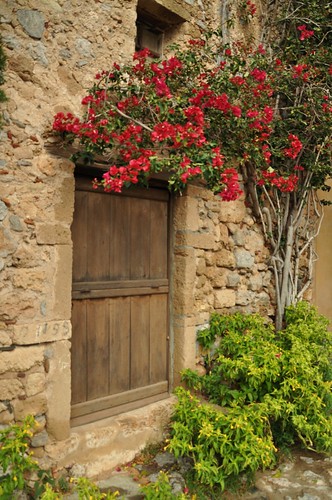
But then we went to Monemvasia. Oh, Monemvasia. It’s in the Laconia region of the Peloponnese (the eastern side of Sparta) and it’s amazing. Apparently the road to the town was only finished two or three years ago, and it’s touted as the gem of Greece that not even the Greeks know about. For a town that for most of the 20th century was described as forgotten, abandoned, and lonely, it is certainly a busy place now, but it seems like it’s still unknown to a lot of tourists. Lots of pictures of it here!
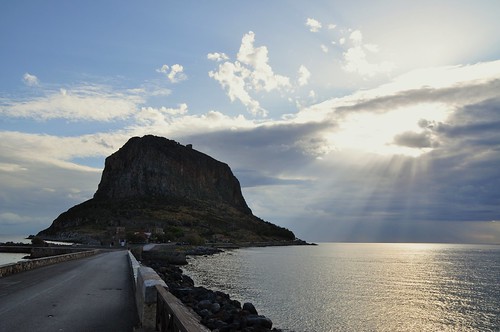
The new town is on the mainland and the upper and lower sections of the old town are on a massive rock that sits a good half kilometre offshore. From what I’ve read, the 300 metre tall rock didn’t appear in the area until the 5th or 6th century AD, after a massive earthquake in the area, and began to be inhabited shortly thereafter. And stayed inhabited right up until the modern age, which is why it’s in such good shape right now. The Romans, the Venetians, and two cycles each of the Byzantines and Turks occupying it meant the town and citadel were constantly revamped.
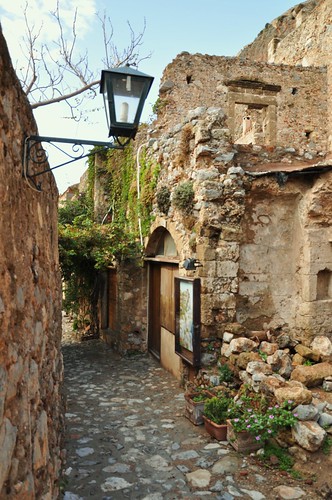
How to describe it, though? Imagine every stereotypical medieval town in Italy or Greece that you’ve seen in cheesy movies. It’s like that. All stone, all winding cobblestone streets and Escheresque staircases that variously lead to private dwellings, stone arches, abandoned churches, portellos through the castle wall, hidden beaches – or they could lead nowhere at all. Then the zig-zag pathway that leads up to the upper town, and the heat and dryness and the cats sitting on the sills of hobbit-sized windows and doorways and the overwhelming smell of flowers. It would be a fabulous setting for an M.R. James style ghost story, which I may just have to write myself and give a ridiculously romantic title like “The Flowers of Monemvasia”.

There are purportedly 26 extant churches in the town, including the main one of Agia Sophia on the very top of the rock. The church of Christos Elkmenos is on the right and the archaeological museum is on the left. Agia Sophia is the best preserved and has frescos and paintings still on its walls and ceilings, and was once the centre of the upper class dwellings on the top of the rock, ie) the best place to be when pirates attacked.
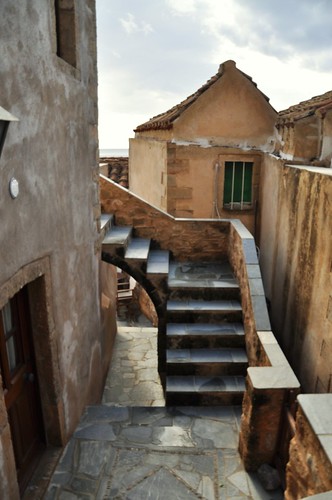
But today it’s the lower town that’s inhabited, with the upper town in complete ruins besides Agia Sophia. I was happy to hear that there are strict regulations for private dwellings in oldschool Monemvasia in order to keep the medieval air about the place. I imagine the people who live in the houses are the types of people who get featured in architectural magazines in articles about how to best preserve your pre-17th century cottage’s plaster walls and hand-tatted lace curtains. Madness. I can’t imagine how much the real estate here is going for, but there are certainly renovations going on, with materials brought in on pack horses because of the narrowness of the cobblestone streets.
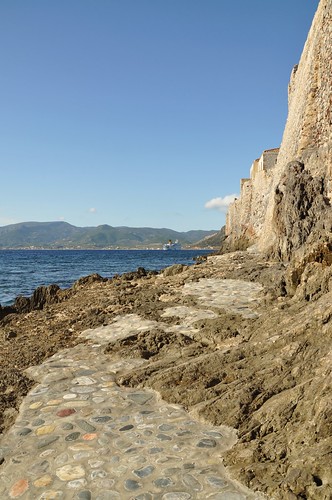
”Vertical rock – all day drinking the boiling sun, holding it in its guts opposite the open sea, and you with your back against the rock, chest open to the sea – half fire, half dew...” - Ioannis Ritsos, a renowned Greek poet born in Monemvasia.
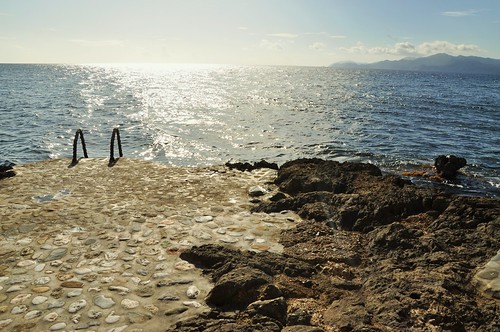
For, you see, any good castle fortification has its value defined by ease of access to water and food once you’ve barricaded yourself inside the walls. And it’s here that Monemvasia is not substantially better off than many of the castles scattered around Greece, because the rock lacks a natural water source – which backs up the theory that the rock is actually a huge chunk of the mainland that fell into the ocean during an ancient earthquake. The archaeological museum offers up the quote “You can find whatever you want in this city, except for water...One neighbour does not even give a drop of water to the other to drink” from a 17th century traveller. Barring travel to the mainland, it was rainwater or nothing. There are still cisterns in both the upper and lower towns that took advantage of just that.

So, yeah. When I retire a billionaire I am going to have a house in Monemvasia for the winters and I’m going to dress up in medieval clothing and faff about all day on sunny terraces playing a lyre or something. It was so ridiculously idyllic. There was a moment on the last morning where Cat and I were sitting on the terrace of a cafe, drinking very fresh orange juice with very warm, very buttery chocolate filled croissants, looking over the terracotta rooftiles to the ocean and listening to the birds singing in the lemon trees beside us...it was surreal. If ever you get to go to Greece, go to Monemvasia, my dears. It’s worth the bus ride from Athens.


But then we went to Monemvasia. Oh, Monemvasia. It’s in the Laconia region of the Peloponnese (the eastern side of Sparta) and it’s amazing. Apparently the road to the town was only finished two or three years ago, and it’s touted as the gem of Greece that not even the Greeks know about. For a town that for most of the 20th century was described as forgotten, abandoned, and lonely, it is certainly a busy place now, but it seems like it’s still unknown to a lot of tourists. Lots of pictures of it here!

The new town is on the mainland and the upper and lower sections of the old town are on a massive rock that sits a good half kilometre offshore. From what I’ve read, the 300 metre tall rock didn’t appear in the area until the 5th or 6th century AD, after a massive earthquake in the area, and began to be inhabited shortly thereafter. And stayed inhabited right up until the modern age, which is why it’s in such good shape right now. The Romans, the Venetians, and two cycles each of the Byzantines and Turks occupying it meant the town and citadel were constantly revamped.

How to describe it, though? Imagine every stereotypical medieval town in Italy or Greece that you’ve seen in cheesy movies. It’s like that. All stone, all winding cobblestone streets and Escheresque staircases that variously lead to private dwellings, stone arches, abandoned churches, portellos through the castle wall, hidden beaches – or they could lead nowhere at all. Then the zig-zag pathway that leads up to the upper town, and the heat and dryness and the cats sitting on the sills of hobbit-sized windows and doorways and the overwhelming smell of flowers. It would be a fabulous setting for an M.R. James style ghost story, which I may just have to write myself and give a ridiculously romantic title like “The Flowers of Monemvasia”.

There are purportedly 26 extant churches in the town, including the main one of Agia Sophia on the very top of the rock. The church of Christos Elkmenos is on the right and the archaeological museum is on the left. Agia Sophia is the best preserved and has frescos and paintings still on its walls and ceilings, and was once the centre of the upper class dwellings on the top of the rock, ie) the best place to be when pirates attacked.

But today it’s the lower town that’s inhabited, with the upper town in complete ruins besides Agia Sophia. I was happy to hear that there are strict regulations for private dwellings in oldschool Monemvasia in order to keep the medieval air about the place. I imagine the people who live in the houses are the types of people who get featured in architectural magazines in articles about how to best preserve your pre-17th century cottage’s plaster walls and hand-tatted lace curtains. Madness. I can’t imagine how much the real estate here is going for, but there are certainly renovations going on, with materials brought in on pack horses because of the narrowness of the cobblestone streets.

”Vertical rock – all day drinking the boiling sun, holding it in its guts opposite the open sea, and you with your back against the rock, chest open to the sea – half fire, half dew...” - Ioannis Ritsos, a renowned Greek poet born in Monemvasia.

For, you see, any good castle fortification has its value defined by ease of access to water and food once you’ve barricaded yourself inside the walls. And it’s here that Monemvasia is not substantially better off than many of the castles scattered around Greece, because the rock lacks a natural water source – which backs up the theory that the rock is actually a huge chunk of the mainland that fell into the ocean during an ancient earthquake. The archaeological museum offers up the quote “You can find whatever you want in this city, except for water...One neighbour does not even give a drop of water to the other to drink” from a 17th century traveller. Barring travel to the mainland, it was rainwater or nothing. There are still cisterns in both the upper and lower towns that took advantage of just that.

So, yeah. When I retire a billionaire I am going to have a house in Monemvasia for the winters and I’m going to dress up in medieval clothing and faff about all day on sunny terraces playing a lyre or something. It was so ridiculously idyllic. There was a moment on the last morning where Cat and I were sitting on the terrace of a cafe, drinking very fresh orange juice with very warm, very buttery chocolate filled croissants, looking over the terracotta rooftiles to the ocean and listening to the birds singing in the lemon trees beside us...it was surreal. If ever you get to go to Greece, go to Monemvasia, my dears. It’s worth the bus ride from Athens.

Friday, October 23, 2009
Olympia and Pylos

Thanksgiving weekend (or at least Thanksgiving for Canadians) everyone as a group headed to the mainland Peloponnese area to go to Olympia and Pylos for some school planned tourism activities. Flickr set!
I am a dorkface and left my camera behind when we went to the Olympia sanctuary site and museum, which is disappointing because it was lovely. Overall the space was bigger, less crowded and shadier than the Acropolis, and the variety of buildings was also really interesting. It’s also where they light the Olympic flame before it starts to travel to the Olympic city – I believe they lit the flame for Vancouver the weekend after we were there. I seem to have continuing coincidences with the Olympic Games. I was born in Calgary in 1988, the last year the Olympics were held in Canada, and I’m attending university in the city hosting the 2010 Olympic Games. Not to mention, you know, actually standing on the site of the first Olympic Games less than six months before the next games themselves.

The range of flora out here still floors me: the Peloponnese is where Kalamata is and everywhere there are groves of olive trees. It’s very surreal to be walking around in mid-October with orange trees, apple trees, pomegranate trees, and ripe olives hanging from every branch. Almonds and dates as well.
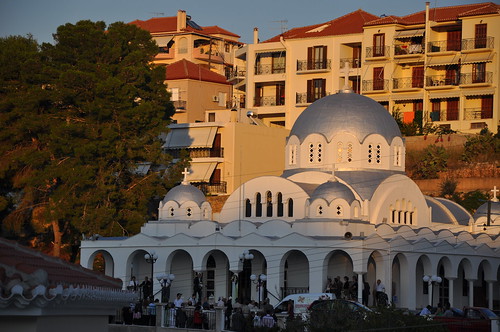
We stayed overnight in Pylos on Saturday, where there were apparently no less than three weddings taking place. It seems like the Greek Orthodox way to celebrate getting hitched is to have the entire wedding party drive around the town square for an hour leaning on their horns the entire time. In other words, “Ow, my ears!” The church in the town is one of the prettiest I’ve seen in Greece so far – the roof is this glossy pearlescent grey that just shone in the dusk light.
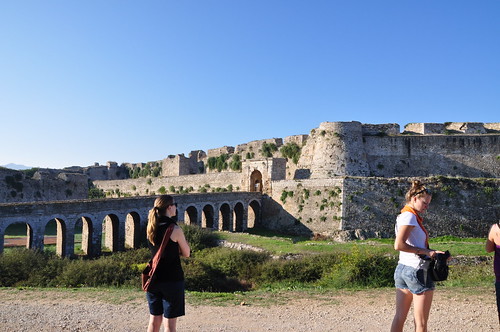
Near Pylos is the Methoni castle and Nestor’s palace. Methoni is the younger site, but is absolutely massive and fascinating. It’s been occupied since the 500s BC by, variously, Spartans, Venetians, and Ottoman Turks. It’s hard to tell from the outside but the grounds of the castle are remarkably sprawling with Turkish baths and walls and towers still standing all over the place, with nothing between North Africa and you but a few hundred kilometres.

Oh, Greece, why you gotta be like this? All turquoise water and ancient ruins. I just don’t know what to do with myself while I’m around you.
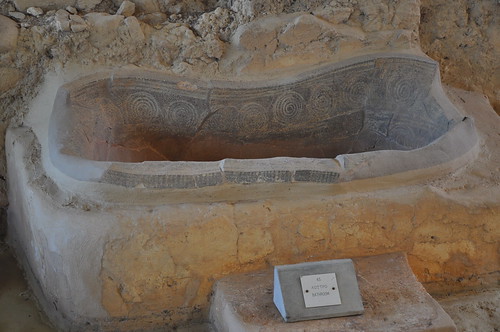
Nestor’s Palace was interesting in an archaeological way opposed the whole “walking on history” style of Methoni. Nestor is a character in the Iliad but Greeks are always eager to attribute places and objects to people from the epics. The above picture is actually of a preserved – wait for it - bathtub in a room of the palace. A large portion of the clay tablet archives were preserved (ie, baked into permanence) when the palace was attacked and burned by invaders. One of the tablets purportedly reads (in Linear B) “The watchers are watching the water – someone is coming (up the coast)”. Ooo, creepy.

An update about the trip to Sparta will come as soon as I’ve finished uploading the pictures , which should be in the next day or two.
Thursday, October 15, 2009
the unknown constellations sway -
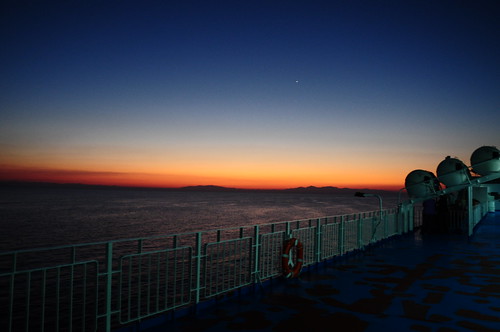
I am going to update soon, I swear. Last weekend the group was on the mainland to go to Pylos and Olympia. This weekend is a long weekend on kefalonia, so I am going to the mainland this afternoon, again, to trek around the Sparta area of the Pelopponese with another girl from the group. Most people seem to be flying out to Corfu/Crete/Santorini but I would rather not get on a plane, no thank you.

It's been chillier than usual the past few days but mostly it makes me miss good old Canadian autumnal weather. Especially Halloween - I believe we are going to have some sort of bonfire/ghost story night to celebrate it out here. I bought a book of M.R. James ghost stories in Argostoli. They're super oldschool early 20th century style ghost stories, and all seem to consist of educated gentlemen going abroad, finding an antique or artifact of some kind (usually from the Crusades, good Protestant that James was) and being visited upon by strange horrors in the night in their hotel rooms. Yeah, just the kind of stuff I need to be reading right now.
And I have come upon this place
By lost ways, by a nod, by words,
By faces, by an old man's face
...
By words, by voices, a lost way - ,
And here above the chimney stack
The unknown constellations sway -
And by what way shall I go back?
-Archibald MacLeish
Sunday, October 4, 2009
Kefalonia

In the summer of 1953 there was a massive earthquake in Kefalonia, which I had heard/read about prior to coming here. I didn’t expect to see the effects of it still so clearly visible around the island.

This rock is about 50 metres offshore of a beach down the road from our apartment. On the lower right hand side of the rock you can see where the sea level was on this side of the island prior to the earthquake – it’s a good metre and a half lower now. If you were to walk/swim along the cliffside to the left of the frame, you would see what used to be sea caves exposed all along the rock face.

Turning left away from the rock. This is the municipal building that we have been using for Greek classes/pottery washing/artifact storage/the occasional movie night. Which leads me to mention my 21st birthday, which was last Monday. Uh, best birthday ever. The first half of the day I excavated the rest of the bone deposit, then I had a nap and watched the first part of Lord of the Rings with the group and ate cake and pizza. I seriously could not have asked for a better day.
Ehhh back to the earthquake! Poros wasn’t an established town until after 1953, when people from the destroyed mountain villages moved down to the sandier coastal areas where their homes were more likely to survive another earthquake. The ancient towns and cities of Kefalonia weren’t usually built on the coast, because the Ionian had a serious pirate problem well even into the 18th century.
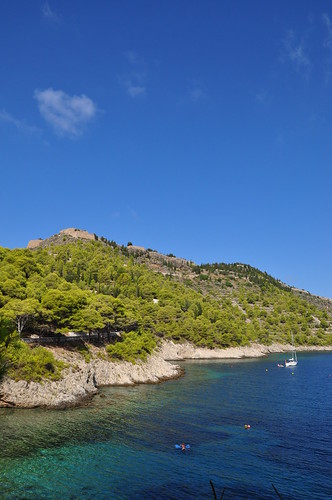
This is a Venetian castle in Assos, on the other side of the island from Poros. Good for hiding from pirates. Pictures from the north side of the island (Myrtos, Assos and Fiscardo) are here. It's much more touristy than the Poros area, which results in the kind of stereotypical whitewashed and brightly painted buildings. Really, really brightly painted, and blindingly bright sky and water. I actually took down the saturation in some of the photos because they were looking a little too neon.

This is also Assos, which actually survived the earthquake better than the southern end of the island. There are a few abandoned, ruined houses in and around the villages by Poros but most didn’t even survive enough to become hollowed out ruins. Just rubble.
Hettie, who works for the municipality and has done a lot of the work to organized the field school, told us some stories about the earthquake. If you talk to someone from Kefalonia who was born before or around the earthquake, one of the first things they often tell foreigners is where they were when the earthquake happened. George, the man who owns the house next to our apartment and who graciously lets us use his washer, was stationed in Australia with the army at the time. After the earthquake something like two thirds of the island moved away. After World War II, the late 1940s Greek civil war and the earthquake, what else could you do? How many more times were you supposed to rebuild?
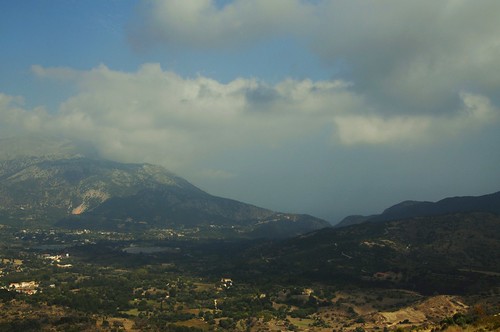
Makis, Hettie’s husband, was six months old in August 1953 and his family stayed on Kefalonia. Hettie told us that the main reason that the loss of life was less than it could have been was because the biggest earthquake happened very early in the morning in a hot month when most people were sleeping outside in their gardens rather than in their homes. Makis was the only one in his family who was still in his house and survived a wall falling on top of him. Another woman Hettie knows says her husband was standing underneath an olive tree when the earthquake hit. He reached up and grabbed onto a branch with both hands to keep from falling, and he was lifted off the ground as the tree turned a full 360 degrees in the ground. That was definitely something new I learned: I knew earthquakes can create up and down movement, and lateral movement, but some also cause sections of land to move in a circular fashion.

Our excavation site is on the slope of this acropolis, the ancient Pronnoi acropolis. Experiencing an earthquake while on site probably wouldn’t be nice, but to honest I worry more often about the effects of the rain on the artifacts and skeletons we’ve exposed. Yet again we had to leave two opened graves exposed over the weekend, a weekend where it (yet again) thundered and rained like hell.
The majority of the graves in the cemetery are 6th century pithoi burials. Pithoi (singular: pithos) are large, kind of almond shaped pots used for food storage. Some people have pithoi or replicas as planters in their gardens in front of their houses on the island, kind of like old barrels and cartwheels in western Canada. Since the burials are on the side of a hill, the ancient Pronnoi people would dig a wide, deep hole and line it with rocks and gravel to keep the burial from collapsing. The pithos would be broken up and rebuilt on its side in the gravel, with the corpse and grave goods placed inside it before the top of the pithos was rebuilt over them. Right now there is a slightly disturbed pithos being excavated – the skeleton is mostly exposed now. There is also another partial, non-pithos burial that was partially excavated last year. This year we had to move a section of wall that had been built over top of the head and torso of the skeleton and, believe me, the head definitely looks like the guy had a stone wall built on top of him.

I haven’t been working on either of the above burials, but I have been clearing out a bone deposit with Julie, the one person here who actually knows her bones (something I cannot claim quite yet). We thought it was just scattered bone from a disturbed burial until Julie found a pair of articulated feet at one end – surprise! Articulated means the feet were in their anatomical position, side by side, as if the body had been laid flat along our bone deposit area instead of buried in one spot and then mixed up and moved to our deposit area. Then this weekend while going through the bones we realized it’s not just one person, but at least two. We need to wait for the local archaeology services to bring up last year’s bone collection to double check, because they didn’t have anyone in the group last year that could identify whether there were multiple people in the bone deposit. Except it’s less a bone deposit and more a burial now. Curiouser and curiouser.

This is the platform visible on the right side of the picture of the municipality building. Yes, I have jumped off it, but it's disappointingly non-scary. :D
Saturday, September 19, 2009
Poros!
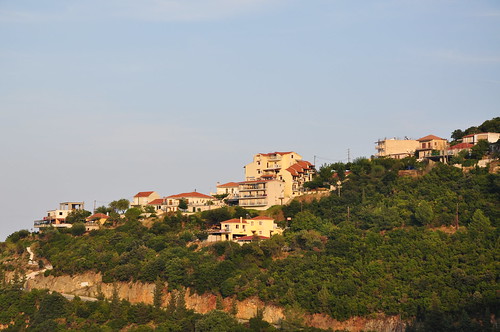
We got into Poros, the town where we’re going to be living for the next three months, on September 11th. So I have been here for a week, I am just too busy to update. Or lazy, whatever. I have definitely become accustomed to the continental lifestyle. Nice.
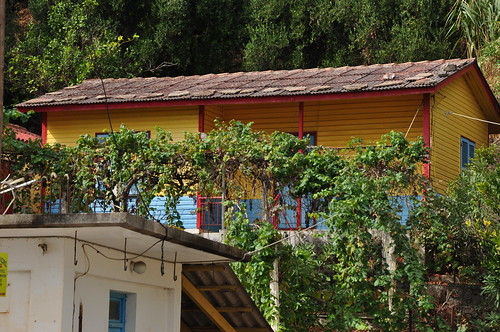
So! This is Kefalonia. We’re in Poros, in the south-east corner. Our excavation site is at the ancient Pronnoi acropolis, which is just west of the town. Kefalonia used to be divided into four city states, and Pronnoi was the southernmost. I shall talk more about our excavation, and the island history, etc., in other posts, because it is darn interesting.
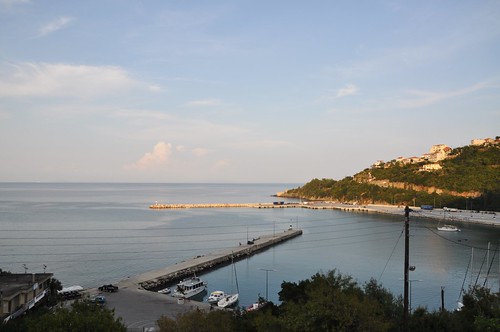
This is the view from the balcony in the two room suite I’m sharing with another archaeology student. Yee-ah. Idyllic. Just a little.

The excavation site is a cemetery on the north-west slope of the acropolis and is a 15 minute drive up this gorge from Poros. Poros itself is very small, but very very friendly. It feels like most of the people in the town recognize our program director, Geoffrey, or one of the townspeople helping organize the excavation (Hettie and Makis). Makis used to be the mayor of the province of Pronnoi on Athens, and Hettie is his wife. They are both so, so kind and accommodating. They’ve organized so much of the trip for us and our stay, and Hettie is always turning up with a special treat or day trip for us. All the islanders involved in our stay – from the bus driver to the reps from the Greek archaeological services – knows somebody whose son has a boat for us to use or has a brother who can get us bike rentals or owns a bar we should go hang out at, etc. etc. Greek hospitality can be a bit overwhelming.
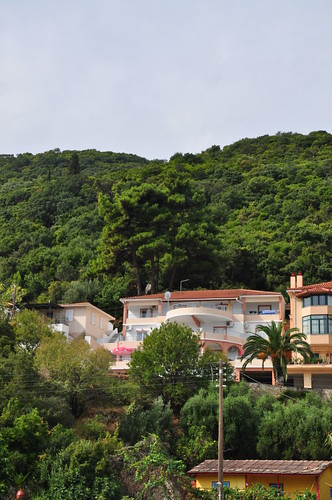
Our apartment complex!

We’ve had two days at the site so far...kind of. Day one was cleaning up the detritus from the past summer and spring. The site excavations began last September with a previous group of SFU students, so no topsoil digging. Yet. Somehow I earned the right to sit on my butt and sort through pebbles for bone fragments with our resident osteology person-about-town, Julie, instead of shifting rocks and using pick-axes to delineate the trench walls again. Not bad for a first day! I will never, ever turn down the opportunity to look for human remains, especially when the alternative is hard labour, haha. A few of the graves have been robbed or disturbed or accidently plowed through with farming equipment over the years, so we worked through a portion of the site where someone’s bone fragments had been scattered. Not much to find – mostly shards of long bones or skulls – but we did find two distal hand phalanges, which are the very tips of your finger. I didn’t say much to anyone, but I was pretty thrilled to find a complete carpal phalange on my first day. I am a great big dorky newbie and all day I was thinking back on the site.
The next day I was really geared to go and start moving some walls and capstones where Geoffrey believed skeletal remains were hidden, but we got rained out. We were taking line measurements (or watching people take line measurements) at about 8:30 in the morning and a thunderstorm poured over the valley on top of us. Le sigh. We’re not back up there for two days, four days after the last day on the site, and I am vaguely worried that some of the bone we exposed has been washed away.
But we’ll see. In the meantime the group has had three organized trips out of town, so it’s not as though I am without things to do.
Tuesday, September 15, 2009
Athens - there is a city by the sea
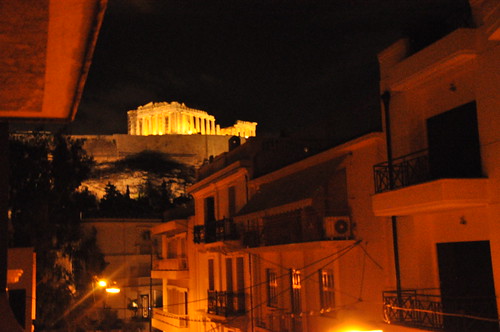
How do I explain this to you? I am sitting on a balcony in downtown Athens right at the base of the Acropolis. The Parthenon is lit up brighter than the streetlights, a hundred times bigger than the moon right on my horizon. It is night, and it is drizzling rain, and there is a loud concert going on at the Herodus Atticus Odeon mere blocks away. More than two thousand years ago people performed at the same theatre, and a woman my age may have sat in her courtyard, chin in hand, hearing the laughter and the flourishes of the theatre the same as I am.
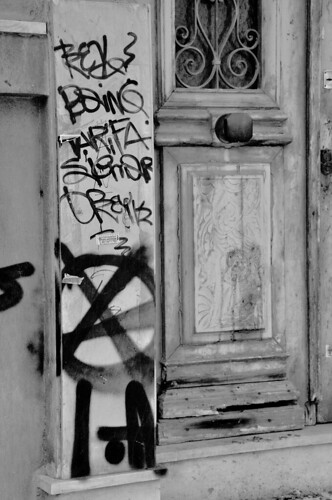
Athens is...Athens. It’s big. It’s noisy, crowded, dirty, overwhelming. Scattered all over the city are preserved archaeological sites, from the centre complexes of the Acropolis, the Agora, and the old Agora to tiny preserved pipes and bits of paved roads, two metres below current street level, just blocked off with railing with no explanation as to their meaning. It was fascinating to see the museums and sites in the city but it’s much too much for me to be comfortable with regularly.

As mentioned above, the hotel I stayed at with the 18 other program students and our program director was right at the south-eastern base of the Acropolis. It was literally a block’s walk to the southern slopes and sites, like the Odeon and the Theatre of Dionysus.
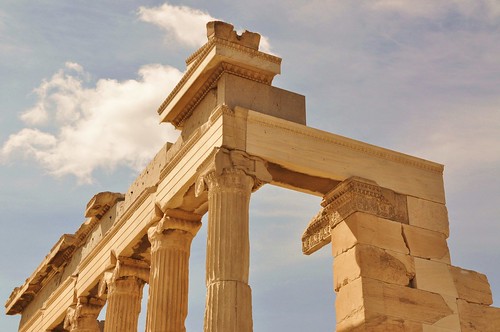
The Acropolis itself is much more than the Parthenon. I will be saying over and over again that Greek archaeology, especially the classical stuff that makes up so much of the Classics departments in universities...well...it isn’t really my thing. I am interested in it, and I really enjoyed seeing the sites, but I don’t have a great deal of background knowledge on it beyond reading a few of the Greek theatre classics. Most of which are decidedly pre-Classical, anyway. I remember having an argument with someone circa grade six about who were cooler, the Romans or the Greeks (the latter of which we were studying at the time). For some reason I took the side of the Romans. Being out here the lines between Greek, Roman and Byzantine all blur together, especially with the works of complete Hellophiles like Hadrian.

I liked the Erechtheum on the Acropolis, and the view from the Pnyx hill offsite. The Parthenon itself was ridiculously overcrowded and blocked by reconstruction efforts. The new Acropolis Museum just off hill, however, was fabulous. It only opened in June and was one of the few places in the touristy parts of Athens where I heard more Greek than English or German or Italian.
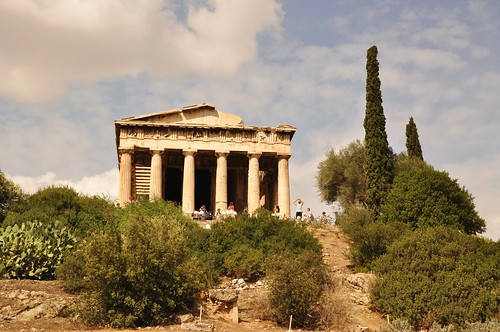
I also really liked the Temple of Hephaestus in the Agora. It’s apparently the most complete example of a Greek temple for its time period, and it’s stunning to see in person. On one side the drums of the columns (the cylinders piled on one another to make up the columns) are perfectly in line; on the other side they are so shifted from earthquakes that they have almost toppled.
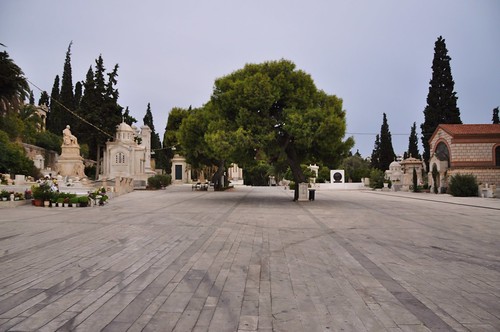
Yeah, like I could go to a city, even an ancient one, without ending up in a 19th century cemetery. I only got about 20 minutes in the First Cemetery because it was sunset and I was paranoid of getting locked in. There were lots of cats roaming around the necropolis, more than I saw in other parts of Athens. Necropolis nekos! They are all so small and scrawny it’s hard to tell which are kittens and which aren’t. I did have one orange tabby follow me around the whole time, doing the exposed-belly pet-me-and-give-me-food pose. Many of the mausoleums were open, with steps leading down to the shrines – perhaps the cats hung out down there? It was very calm, and quiet, and peaceful, and absolutely enormous.
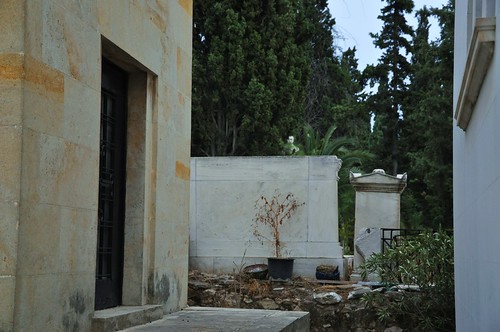
This was the only time I got freaked out in the cemetery. Can you see why?

Yup. Creepy statue man is watching you. Almost all the statues faced into the main central avenue, but this guy didn’t, so I was not expecting to see his face poking through the trees. Thanks for the adrenaline rush, creepy statue man.
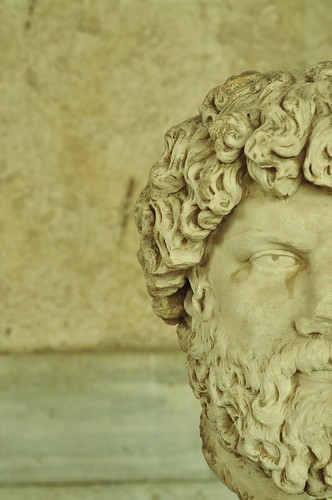
The museums in Athens were incredible but, again, overwhelming. Besides the Acropolis Museum, there was an archaeological museum at the Agora (where most of my statue pictures are from) and the National Museum, which I adored and wish I had had more time at.

Indication that something is possibly wrong with me: I’m in Athens, at the National Museum, which is full of all manner of Greek archaeological goodies, and where do I hang out? The Egyptian wing. Yeeeah. The Egyptologist wanna-be in me couldn’t pass this section of the museum up. Once again, the classical Greek stuff isn’t really my thing. Unless it involves spindle whorls. My ‘thing’, if I can be argued to have a ‘thing’ within archaeology at all, is definitely osteology and textiles. This should come as no surprise to anyone ever.

They had a nice little sampling of Egyptian harp related stuff. The above is part of a wooden harp found preserved (cannot remember the date), and the next two are, in order, a monkey playing a harp and a very special carving of two people and a harp that speaks for itself. I took a picture of it just for you, Becca.
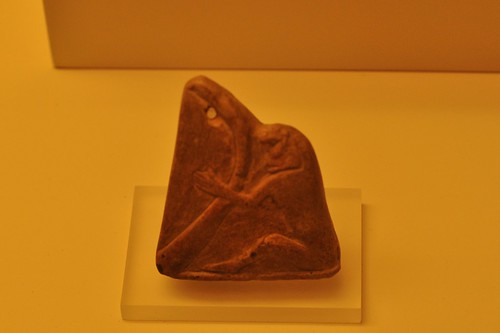
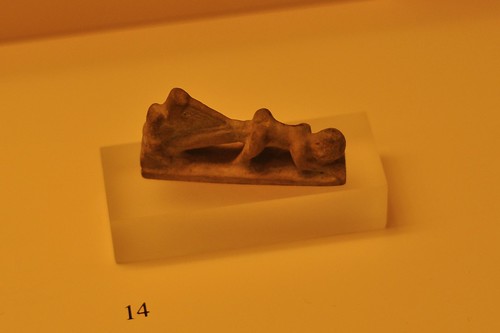
This is my favourite picture I got out of the two days in Athens – it’s a fresco in the Byzantine church on the Agora grounds. I blew out the contrast and the saturation on it and quite like the result.
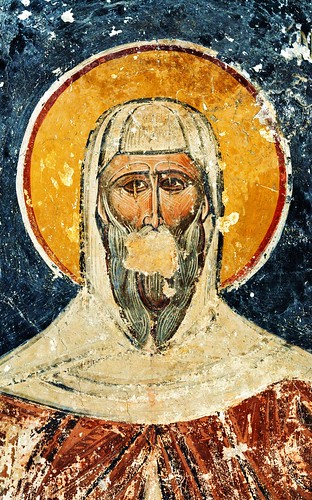
Subscribe to:
Posts (Atom)